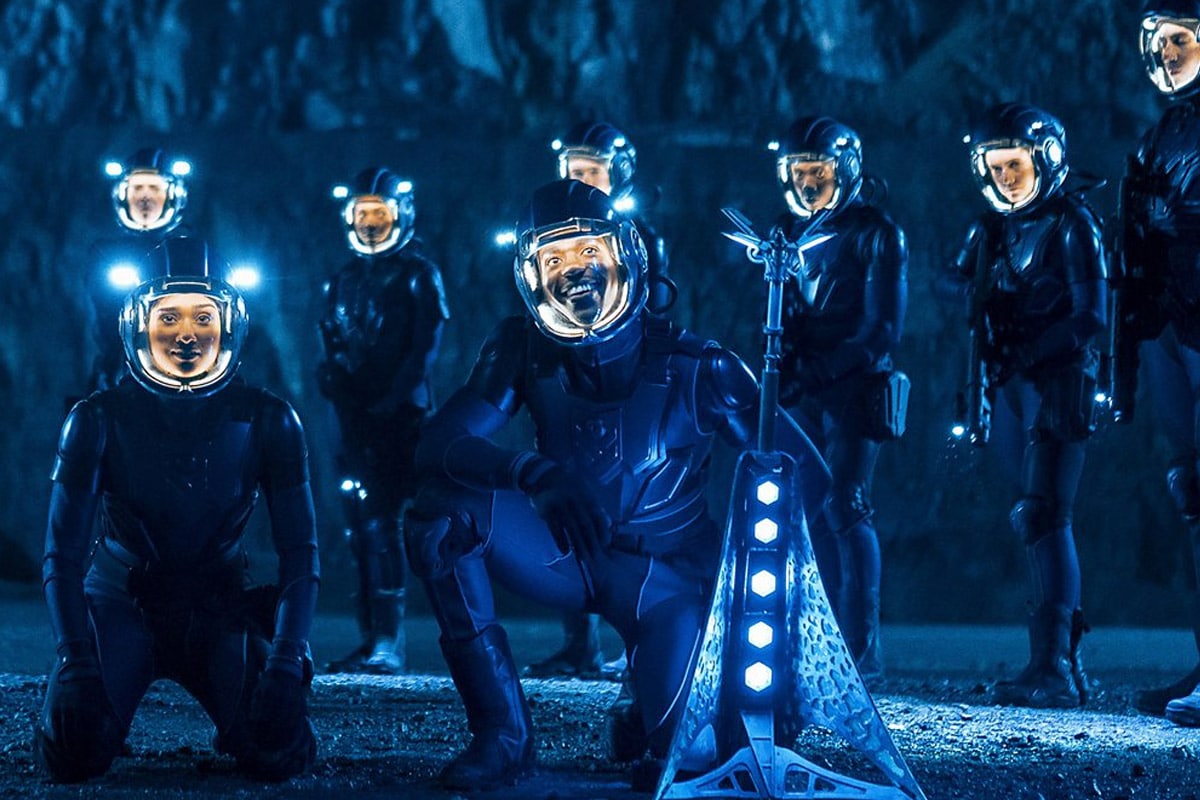- Series: 10
- Episode: Six
- Duration: 48 minutes
- Writer: Steven Moffat
- Director: Daniel Nettheim
“Only in darkness are we revealed”
Well there you go. After such a strong, refreshing and delicately unfolding entrance, new companion Bill Potts gets killed two episodes in a row. Of course, both are a cheat – but both are unsettling, mainly thanks to the thoroughly likeable companion Pearl Mackie’s brought to the TARDIS. But the recall to the sorry plight of Rory Williams — a companion who quickly stacked up a death count bordering on the comical during Series Five — is notable.
Rory was put through the mill during Steven Moffat’s first year as exec, lead writer and Doctor Who show-runner at large. It was also the year that made him synonymous with tangled arcs, although it would take a further series for that to reach a muddled and mixed peak.
The final remake
Extremis can be viewed in two ways: A twist on the invasion story, heightened as a last hurrah for the style of arc story-telling that rightly or wrongly Moffat pioneered during his time on the series before he boards his own time-ship to get the hell out of there, or; simply a remake and shortened correction of the sprawling and unsatisfactory Silence/Silent arc that dominated the Eleventh Doctor’s life. Perhaps the truth lies somewhere in the middle, although the truth is a malleable thing when it comes to these new invaders or the Silents who came before them.
Extremis certainly taps on some key elements of that earlier arc. The monks hold more than a passing resemblance to Silents, creeping through Earth, rasping through open mouths, readily attached to religious symbolism, and merrily jabbing their pointy fingers at victims. Their excursions through windows of another, our, reality are much like Silent Chief Madame Kovarian’s mysterious appearances in the early part of Series Six. There’s even a trip to the Oval Office come the resolution, but this time a contemporary — if Trump-dodging opportunity — rather than the more welcoming and lavish one the Silents stalked in The Impossible Astronaut.

A bit of a warning now: while not a fan of pinning reviews of fiction on plot holes or logic, potentially the last chance to get to grips with a Moffat riddle makes it unavoidable.
As a simultaneously new and old conspiracy thriller, Extremis doesn’t hold back on ticking cultural references and the dark side of Who Moffat finds irresistible. There’s little surprise there’s finally a title that translates as forwardly as “At the point of death”. The emphasis on death, while tied into the resolution, comes as quite a shock in a so far mannered series. There’s an edge to this darkness harking back to Series Eight’s Dark Water, that even breaks from the murky groundwork laid by Oxygen’s walking corpses and the melodramatic reveal of the Doctor’s blindness.
A world of darkness
And that blindness is as worrying as it appeared at the cliffhanger of the previous episode. And that’s not in the raising the stakes. It’s a twist that hasn’t managed to transcend the sense that the Doctor will overcome it, or simply that it’s not threatening enough to limit the Doctor. It’s just that keeping it secret from Bill, despite broadcasting it to the villains of the piece come the end, shows a lapse in logic. The climax provides a way out, but Moffat instead opts to ramp up the idea of the Doctor in the darkness, facing an oncoming storm as the main crux of the cliff-hanger.

Back in time
That avowal is made against the wall of the vault, the occupant of which a signifcant part of Extremis is dedicated to teasing. The story’s broken up by sporadic episodes that relate the events that “happened long ago” as the Doctor’s previously alluded to — and therefore to who or what lurks in the Vault. Or so it seems. The revelations have a mixed effect. Pointed dialogue at the start really do suggest, furthering the episode’s link to The Impossible Astronaut, that the Doctor’s for the chop. But of course, he’s not the prisoner here, and certainly not the executioner. This is Missy’s long-awaited return… And she’s really not quite the same as she was. Michelle Gomez’s performance is for the most part reserved, no doubt to increase the magnitude of the ruse, but serves to stall the anticipation given the recent revelation that Gomez has quit the role. A Master announcing her departure, that’s a change and a key to how important Missy has become to the Twelfth Doctor’s tenure. But even on the diegetic side, it all adds to Extremis’ concerted campaign up the impending sense of closure.
The Missy segments occupy their form of reality — and are framed very much like a film. It’s a trick that looks impressive, but the long fade to black and silent transitions are distracting even with the revelation we’re peering into another world. In fact, it leaves the nagging impression that things aren’t quite out of the virtual confusion come the end. given the tricks pulled in the sixth and eighth seasons, it’s unlikely this alternative reality is a mere trailer.
Death
There are plenty of shadows in Extremis. The shadow people of the shadow world undermining an “evil demon”. But the real shadow remains death. During the prolonged execution sketches, the Doctor’s role as the greatest mass-murderer of all time-space pops up, probably in the most gratuitous way yet — and that’s saying something in Moffat’s reign. It still sticks in the throat, even with the Twelfth’s morbidly-leaning persona. What was wrong with the universal protector trying to patch himself out of existence? Must have been Neil Gaiman’s pinioning of the idea in Series Seven’s A Nightmare in Silver. But do we need to be reminded, not how comfortable the Doctor is with his sacrifices, but how he’ll use them to his advantage? Repeatedly. His cool association with the galactic executioners may fall to an uneasy reliance on universal custom, but compare to the Eleventh Doctor’s glorious threats at the end of The Eleventh Hour (Series Five).
Doctor Who’s body count has long been laughably high, an excellent way to measure the length of the series along with unconsciousness and being locked up. But Moffat’s insistence on continual teasing the Doctor aswar criminal feels increasingly sadistic. Especially when it slots more on the side of the needs of the few.
Hopefully it’s the last gasp of Moffat’s insistence on associating the show with death, for the sake of this so far warm and successful series. the Eight series was mired by a strange nihilism, Series Nine by an arc without a pay-off. Could Extremis be a tipping point?
Tellingly, Bill’s point still stands come the end: “How is blowing everyone up saving the world?”
Shadow people
“… You’re sending us into the dark after a man with a gun.”
As an invasion, Extremis offers a novel twist in Who-lore, and in doing so it neatly dispensing with the clutter and baggage of resolution that the Silence arc threw up. But serving up death as the only escape, it also leaves a maudlin taste. We hear of constant suicides, see the President of the United States slumped in a chair at the White House, and see the TARDIS crew eradicated. This small sentient world may only have been around for a repeated loops of a few hours (as the monk says, they’ve killed the Doctor repeatedly), but its destruction is total.
There’s been some praise for the secret of the piece being so bedded, in plain sight, in the beginning of the episode — the translators who kill themselves. But when posed as a rebellion, the idea of immediate runs aground. Surely, far from being a rebellion, a suicide confirms to the invaders who the strongest are? The Mario analogy only works if you knew you wouldn’t be recreated as this Matrix enters each subsequent iteration, but no character seems to have that awareness. And re-running the simulation while whittling down the trouble-makers is counter-productive. Surely, the true rebellion would be to hide and survive in the construct, or engineer their deaths without evidence of a suicide, knowing their true selves could help repel the incursion in the without being sign-posted.
As ever, quibbles with a fictional world are fairly pointless. But while Extremis serves up some memorable scenes, it just dwells on the rancid a little bit too much and in too-scrappy a style. It’s a clash that may be framed in a more forgiving light by the following two weeks, but as it stands alone in Series 10, it’s not an easy fit.

Different worlds
“Because… this isn’t the world!”
Parallel realities aren’t uncommon in Who, and Extremis makes for a notable addition. It’s not simply that there is a parallel world, but how it sets up the true meat of the mid-season revelations. That’s just as well when the logic of the an episode that priorities surprises and shocks is fairly weak.
The Cern episode apparently exists purely to demonstrate the number synergy — which betrays a construct that can’t be very old at all. Aside from whether you can really test individuals that are so evidently coded – as the Doctor calls them, sub-routines – it’s surely something that could have been spotted any time someone asked a group how many sugars they’d like int heir tea — let alone in a centre of scientific excellence.
Teasing
“It’s like Super Mario, figuring out what’s going on. Deleting himself from the game, because he’s sick of dying.”
But the trick here isn’t to hinge on any particular switch revelation in the past, like guessing when Amy Pond was kidnapped in the sixth series, but to kick-start a two part invasion story where the two opposing sides know each other. The bigger picture is that this is the start of what looks like a three-part story, pulling in two other established writers, Peter Harness and Toby Whithouse, to shape an invasion story with a difference. A further twist on the staple after last series’ Zygon Invasion and Inversion. On the way to setting that concept up, the liberal grabbing of Dan Brown, the Wachowski’s, and countless other peddlers of conspiracies and hidden societies can’t really be faulted.
But come the end of the episode, the knowledge of an impending invasion lies solely with the Doctor and there’s pretty little other knowledge along with it. It’s not simply that a great deal needs to be picked up next week, it’s that this was less the first part of an invasion trilogy than a slight and disturbing warm-up.

The whole layering of the Doctor’s missing eyesight in an imperceptible universe is a bit lost. The heavy pop-culture references demand a strength that isn’t quite there amid the darkness. That final gung-ho hook suggests a show dangerously on the verge of eating itself:
“What everyone does when the world is in danger — calling the Doctor!”
to end on a positive, there’s the promise of a whomping and alternative scrap coming up and finally, finally, this series has served up a monster. It’s a sign of the season that it helps Extremis stick out, and that it doesn’t feel quite right.
Stunning moment
Well, let’s split it between to comedy and tragedy. The Pope’s interruption of Bill’s date is as funny as the Doctor’s cake entrance in Series Five’s Vampires of Venice. In fact, it’s the perfect successor. Bravo. Cut to the end and the creeping, silent Oval Office with the President’s corpse propped in a chair is utterly extraordinary. Series 10 continues to push boundaries.
Everyday hook of the week
The idea of living in an computer construct isn’t exactly every day but… I mean, it isn’t… is it?
Doctor look of the week
This section just doesn’t get easier. but lets say when he sets eyes on Pope Benedict IX. he does look rather familiar, even if it all seems a little more Tenth Doctor than this sly old ‘dog’… Most probably it was.
Production touch of the week
The Vatican libraries of the apocryphal and heretical are brilliantly produced, understandably affecting the show’s pre-publicity campaign. But let’s hand it to the beautifully filmed segments that make the most of Doctor Who’s southern Welsh home, specifically St. Andrews Quarry in Dinas Powys.
A Jokerside view
A Whisper Man, a Silent and an invading monk walk into a bar and take a long, long time to order…
Vault action
The Doctor, the real Doctor, doesn’t leave the vault in the contemporary. He paws at it, talking at several points to Missy. It’s so utterly explicit – from the strange order to Nardole to take her to the Vault, when the earlier dialogue suggests the hooded android has little reason to know what that is – that any reveal would be an anti-climax. No, not at all. That Vault must be empty…
Verdict
The Da Vinci Code, The Matrix, Harsh Realm, that time the cat next door jumped into your face twice… The construct of a false, AR world is well developed in popular culture and action science-fiction. But Extremis isn’t really about the concept as much as the set-up. For that reason, come the end it doesn’t quite feel that it’s heart is in it. in fact, it all hinges on an email and that’s not quite enough to make up for the inner misery and horrors the TARDIS crew are rather mean-spiritedly put through.
It’s a paradox, Unfairly, with the score and promise that comes with the arrival of a peak season three-parter, it seems wrong that the tenth series is kicking into gear with an episode so different from its predecessors. If it’s intended as a neater remake of the Eleventh Doctor’s arcs, Extremis is a great success. But let’s hope the real homage comes int he confirmation that this is all be part of something more. And I don’t quite mean AR.
Review previously published on Medium (May 31, 2017)









0 Comments